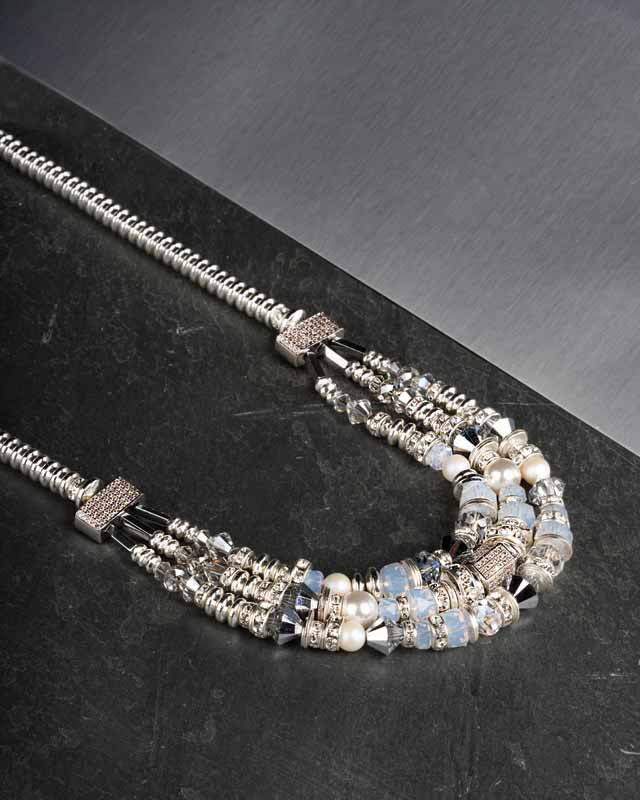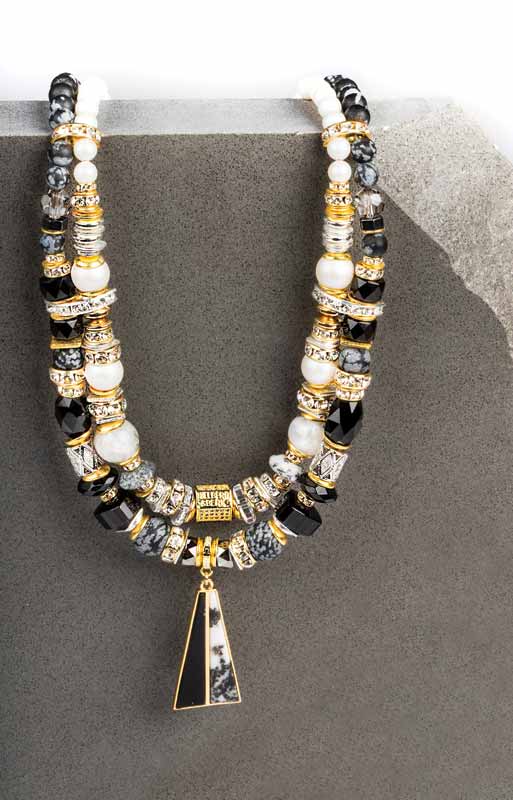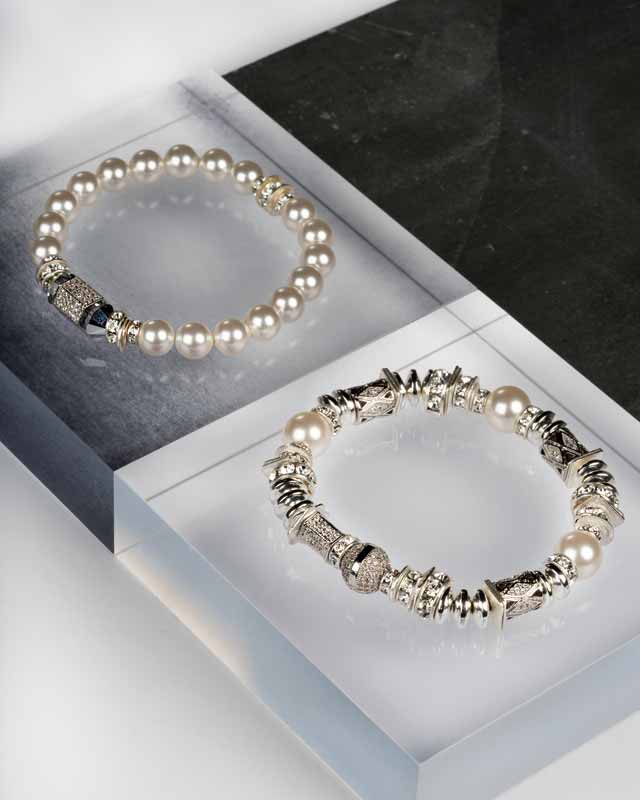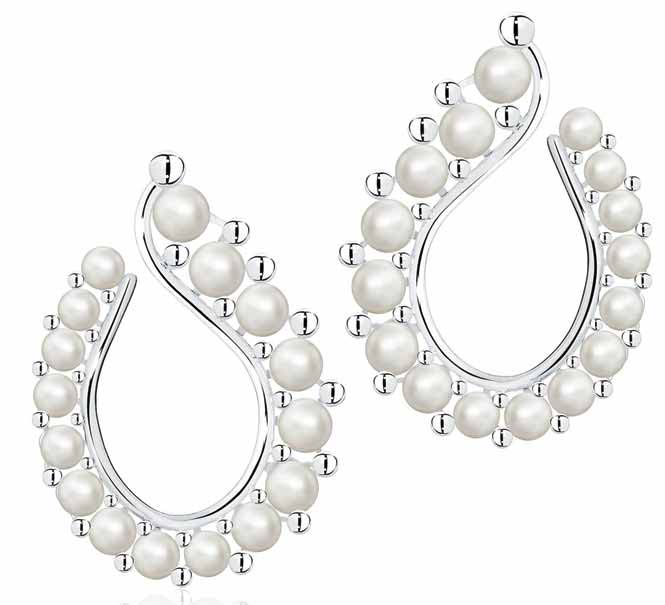Boosting your bottom line with sterling silver
by Samantha Ashenhurst | February 22, 2019 10:29 am
By Dasha Moller
 [1]
[1]Silver is sometimes looked at as secondary to gold. However, offering silver pieces (including gold-plated items) can make jewellery more accessible, increase turnover, and help retailers reach a wider customer base.
Saskatchewan-based brand Hillberg & Berk, for example, has a unique perspective on silver jewellery. The company’s founder and CEO, Rachel Mielke, began making jewellery at her kitchen table in 2005. Today, with more than 65 wholesale and nine retail locations, the brand she started is shaking up the sterling silver sector.
“Silver offers an accessible price point for a really wide variety of customers,” she says. “We have customers that start in their teens or even younger, and we have great-grandmas that come into our store, so what I love is to make quality lifetime pieces at an affordable price so we can really open up to a broader demographic.”
Why offer silver?
Affordable luxury is not new in retail, but has yet to be fully exploited in the jewellery sector. The origins of jewellery are deeply rooted in tradition and heritage. The mindset that jewellery can be affordable and ephemeral or short-lived is a new concept in the industry. Yet, customers desire to accessorize their wardrobes with pieces that can appear luxurious and/or are trendy, but fall within reasonable retail prices—pieces that can be bought on a whim and worn for a few months without financial planning.
“Sterling silver jewellery allows our brand to be accessible in the market, offering luxury styles at an attractive price. It also allows us to address fashion trends at an accessible cost, which motivates clients to shop us more often for those ‘just because’ purchases,” says Aynsley Knight Mariani, public relations director for Montréal-based Birks Group. “A client can come in and purchase a pair of sterling silver and baroque pearl earrings for a night out at under $500 while still making a statement.”
Traditional gold product is still the bread and butter of jewellery, but customers also desire more affordable pieces to add to, combine with, and renew their wardrobes for different occasions and to keep up with changing trends. In North America, many consumers are turning to sterling silver to supplement the jewellery they already have, according to Mielke.
 [2]
[2]“A lot of people have fine jewellery, but they’re augmenting with sterling silver because there is a desire to accessorize your outfit more often,” she says. “Women want to accessorize their outfits on a regular basis. They don’t want to wear the same pieces every day. So, I think we see a big demand for silver product because of this desire to be able to change your accessories more frequently.”
More bang for your buck
According to the online investment about gold service, BullionVault, sterling silver cost US$15.68/oz (US$0.50/g) and gold cost US$1288/oz (US$41/g) in January of this year. This is a gold/silver ratio of 82—in other words, 1 g (0.03 oz) of gold is equivalent to 82 g (3 oz) of silver at market value.
Using the example of small, heart-shaped silver stud earrings (5 x 5 mm [0.2 x 0.2 in.] to 7 x 7 mm [0.3 x 0.3 in.]), which normally weigh just under 1 g per pair, you could purchase about 82 pairs in silver for the same price as one pair in gold, just considering the metal quantity invested and assuming equivalent weights and excluding wastage.
Silver gives greater quantity for the same metal investment, which gives the jeweller more budget flexibility to either offer more pieces, add pearls and gemstones, or invest in design (increased labour).
To demonstrate, consider a hypothetical seasonal investment of US$1000 for an individual jewellery store. With that amount, an entire showcase or store window can be replenished with new and on-trend pieces in sterling silver (considering minimum purchase orders from a local distributor). Due to the metal’s price, this is simply not possible with gold. With silver, a jewellery store can be overhauled with a fresh collection at a fraction of the price. This does result in more inventory to sell, but it can also create less product risk—if the customer does not like one of the pieces, they can choose from others.
| STEPPING UP TO THE PLATE |
 [3] [3]Rose and yellow gold plating on sterling silver can be a very attractive alternative to solid gold. Nevertheless, it is critical to establish plating standards and ensure regular testing to avoid any surprises, especially when completing first orders. Plating standards are defined by thickness in microns. Working with a minimum of 14-karat gold is recommended, as it provides a nice hue similar to gold metal. It is best to avoid flash plating, as it is more appropriate for the costume jewellery sector. Electro-coating (e-coating) is a transparent coating that can be applied to gold-plated silver jewellery to provide added protection from tarnishing or colour loss for a period of time. This is especially useful in humid climates, although this technique can make rose gold slightly darker in colour. Many brands also have guidelines and standards in place to ensure plating quality. “Defining what standards you want to use for your product and being willing to stand behind it is so important,” says Rachel Mielke, founder and CEO of Hillberg & Berk. |
Higher turnover
 [4]
[4]Lower investment risk and higher turnover directly affect the sterling silver portfolio’s bottom line. According to Euromonitor’s Jewellery in Canada report from July 2018, “The costume jewellery category recorded faster value growth than fine jewellery in 2017 and 2018, and costume jewellery is expected to continue leading[5] in terms of value growth.” This is significant as many consider silver to be the midpoint between costume jewellery and gold.
Euromonitor also reported Canada’s growth in costume jewellery was driven by fashion retailers such as Alex & Ani and by the continued expansion of mid-luxury department stores such as Nordstrom, Saks Fifth Avenue (along with the off-price Saks Off Fifth), and Simons. It further highlighed the continued leadership of Swarovski in the metal sector and Pandora in sterling silver. These brands specialize in entry price-point products with high turnover.
Gold-plated or otherwise, silver is the ideal metal to test new or trendy products at a fraction of the investment. It is also worthwhile to remember sterling silver, like its gold counterpart, can be refined for recovery.
“There’s certainly large demand for sterling silver jewellery. It’s why Hillberg & Berk has been able to scale so quickly,” says Mielke. “Every business is being bombarded by global changes in consumer purchasing habits, trends, and globalization, and I think there is a big opportunity for jewellery stores to expand into sterling product, augment their offerings, and appeal to a wider consumer base.”
Rose and yellow gold are also recognized as on-trend metals, so plating sterling silver pieces in these materials can help you draw in customers.
“We’ve become really known for mixed-metal designs. Within one design, we might have both sterling silver and gold-plated elements. That works well for us,” says Mielke. “We found a lot of our customers have yellow gold wedding rings and wanted to wear sterling silver jewellery and felt that it wouldn’t work, but we have shown there are no rules—you can mix and match.”
BBC News described rose gold as “the fashion trend that just won’t go away” in an article it published in July 2018. This metal has been going strong since 2014 and seems on track to continue that way at least until 2020. However, the industry should keep an eye on the bronze watch trend to see how that will impact rose gold in jewellery[6]. A trend toward bronze could decrease interest in and sales of rose gold pieces.
A good deal
Ultimately, sterling silver is a strong option for jewellers looking to broaden their appeal without increasing costs.
“Sterling silver offers the opportunity to attract an entry-level self-purchasing client while also offering an extensive selection for gifting opportunities under $500,” says Knight Mariani.
Mielke says Hillberg & Berk’s portfolio is almost entirely sterling silver, adding that its fastest-growing segment is currently the jewellery store.
Enthusiasm for sterling silver is catching. Together with higher turnover and potential to attract new customers, this metal offers a good deal where you can get more bang for your buck.
| BEYOND SECOND PLACE |
 [7] [7]The following are a few advantages you could point out when selling silver jewellery to customers who are fans of gold. Experiment with silver If a customer would like to try a more daring look, but is hesitant to make the investment in gold, silver jewellery (with or without gold plating) is a less costly way to try a new trend. Travel with silver It can be less worrisome to travel with silver jewellery than gold. This is a nice option to prepare a vacation wardrobe with less stress if something gets lost. Silver for teens The youngest customers will have lower budgets, but also want to start making their own purchases. Silver jewellery is a good starting point for creating or maintaining jewellery tradition. Gift-giving in silver Silver is an easier metal to choose for smaller gifting opportunities. |
 [8]Dasha Moller is a jewellery professional who has recently returned to Canada after living in Europe for 20 years. With almost 15 years of experience in the jewellery industry, she has worked with a diverse range of jewellery portfolios, including women’s, men’s, and children’s jewellery, celebrity collections, and sports merchandising. Moller can be contacted via e-mail at dashamoller@gmail.com[9].
[8]Dasha Moller is a jewellery professional who has recently returned to Canada after living in Europe for 20 years. With almost 15 years of experience in the jewellery industry, she has worked with a diverse range of jewellery portfolios, including women’s, men’s, and children’s jewellery, celebrity collections, and sports merchandising. Moller can be contacted via e-mail at dashamoller@gmail.com[9].
- [Image]: https://www.jewellerybusiness.com/wp-content/uploads/2019/02/AW-Styled-Product0265-2-Edit-1.jpg
- [Image]: https://www.jewellerybusiness.com/wp-content/uploads/2019/02/earrings-crop.jpg
- [Image]: https://www.jewellerybusiness.com/wp-content/uploads/2019/02/AW-Styled-Product0277-Edit-V2-1.jpg
- [Image]: https://www.jewellerybusiness.com/wp-content/uploads/2019/02/AW-Styled-Product0272-2-Edit-1.jpg
- is expected to continue leading: https://www.euromonitor.com/jewellery-in-canada/report
- impact rose gold in jewellery: https://www.bbc.com/news/business-44757499
- [Image]: https://www.jewellerybusiness.com/wp-content/uploads/2019/02/earrings2-crop.jpg
- [Image]: https://www.jewellerybusiness.com/wp-content/uploads/2018/06/Dasha-Moller-2017-High-Res.jpg
- dashamoller@gmail.com: mailto:dashamoller@gmail.com
Source URL: https://www.jewellerybusiness.com/features/boosting-your-bottom-line-with-sterling-silver/